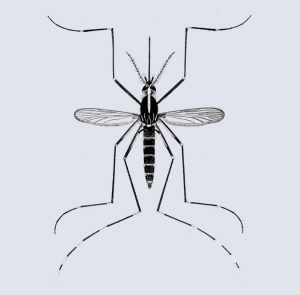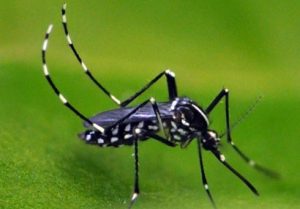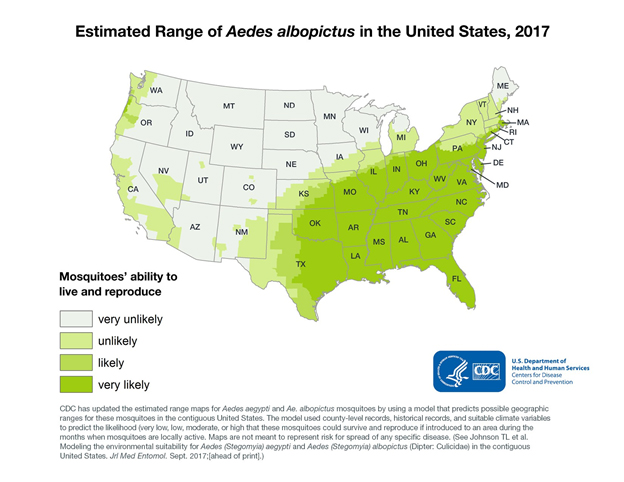Aedes Albopictus
 The Asian tiger Mosquito (Aedes albopictus) has a white and black pattern that resembles the stripes of a tiger on its legs and thorax (neck area).
The Asian tiger Mosquito (Aedes albopictus) has a white and black pattern that resembles the stripes of a tiger on its legs and thorax (neck area).
Aedes albopictus, also known as the (Asian) tiger mosquito for its black and white stripes, is the number one nuisance mosquito in Northern Virginia, Suburban Maryland, and DC (the DMV) biting more people each year than any other. Aedes albopictus hitchhiked to the US in the 1980s from Japan in shipments of used tires. It has since colonized the entire Atlantic Seaboard from Florida to Maine and various other parts of the country.
Asian tiger mosquitoes are container breeders and, in most cases, breed in artificial containers such as buckets and garbage can lids, tarps, old tires, birdbaths, rain barrels, clogged roof gutters, corrugated plastic downspout extension, plastic children’s toys and the like. They will also breed in natural containers such as tree holes or rocks with indentations. Asian tiger mosquitoes only need a tablespoon of water to complete their development from egg to adult. They are closely related to Aedes aegypti, the yellow fever mosquito, but prefer suburban environments with dirt, grass, and canopy. If Aedes aegypti is the urban mosquito, then Aedes albopictus is the suburban mosquito. In warm and humid regions, tiger mosquitoes are active year-round, but in more temperate regions like the United States, they diapause (a period of suspended development) in the egg stage where they can tolerate snow and below freezing temperature. This explains their prevalence in the greater Washington DC area and their successful colonization of much of the United States in the last few decades.
Asian tiger mosquitoes practice skipping oviposition, where they cryptically deposit their eggs in various floodable containers. The females do not put all of their eggs in one basket. Out of the 150 to 200 eggs they lay per oviposition, they will lay 10 in one container, 20 in another, and so on. A deep understanding of the tiger mosquitoes’ life cycle is critical to proper control.
 Asian tiger mosquitoes can fly up to a mile in their lifetime and are active during daylight hours through dusk. They spend most of their time in humid, wind-free environments resting on foliage such as under a bush and waiting for a dog, cat, or human to pass by so they can feed. Asian tiger are persistent and furtive feeders. They approach people cautiously and secretly to bite their ankles and the back sides of their arms and legs. While they inject saliva immediately when injecting their proboscis, they will stop feeding and fly away should their victim move. They might feed on dozens of people to achieve a blood meal and potentially spread disease to all bitten. The habit of biting numerous people and animals makes Aedes albopictus a vector for at least 20 diseases, including yellow fever, Rift Valley Fever (RVF), chikungunya, West Nile Virus and various forms of encephalitis. Aedes albopcitus was responsible for the 2011 and 2016 dengue outbreaks in Hawaii.
Asian tiger mosquitoes can fly up to a mile in their lifetime and are active during daylight hours through dusk. They spend most of their time in humid, wind-free environments resting on foliage such as under a bush and waiting for a dog, cat, or human to pass by so they can feed. Asian tiger are persistent and furtive feeders. They approach people cautiously and secretly to bite their ankles and the back sides of their arms and legs. While they inject saliva immediately when injecting their proboscis, they will stop feeding and fly away should their victim move. They might feed on dozens of people to achieve a blood meal and potentially spread disease to all bitten. The habit of biting numerous people and animals makes Aedes albopictus a vector for at least 20 diseases, including yellow fever, Rift Valley Fever (RVF), chikungunya, West Nile Virus and various forms of encephalitis. Aedes albopcitus was responsible for the 2011 and 2016 dengue outbreaks in Hawaii.
This repeated feeding creates greater possibilities for an Asian tiger mosquito to contract and transmit viruses like Zika. It takes an average of 7 to 10 days for a mosquito to become infectious after they bite a positive person. Therefore, if a seven day old female Asian tiger mosquito bites someone and acquires Zika, the virus can spread from the mosquito’s gut to its saliva glands in 10 days. That mosquito will likely spread the disease to every person it bites for the remaining three to four weeks of its natural life. The one piece of good news is that unlike Aedes aegypti, Aedes albopictus does not prefer humans to other animals, and this could slow the spread of disease. The flip side is that Aedes albopictus is better at transferring diseases from animals to humans, such as West Nile Virus.
While Aedes albopictus has not been confirmed to have communicated any cases of Zika, it is believed by many in the public health community that the Asian tiger will be responsible for localized transmission of Zika within the continental United States.
The introduction of exotic species like Aedes albopictus is a regrettable result of our globalized world. While it is wonderful that we safely travel to once remote parts of the world, this also allows deadly animals to stowaway and like the Asian tiger mosquito, make a new home in the United States. It now appears too late to expel Aedes albopictus from the United States. However, its numbers can be reduced, and thus disease transmission can be reduced. This can be done by inspecting your property every week for standing water, no matter how small. It is also advisable to sign up for regular all natural mosquito treatments that reduce the mosquito population but do not harm beneficial pollinators like bees.

